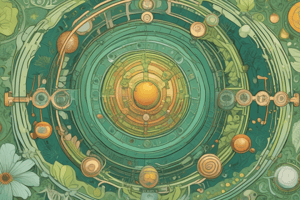Podcast
Questions and Answers
Which of the following is NOT a key area of study within biology?
Which of the following is NOT a key area of study within biology?
- Ecology
- Cell biology
- Genetics
- Astrophysics (correct)
What is the primary energy currency of cells in all living organisms?
What is the primary energy currency of cells in all living organisms?
- Glucose
- ATP (correct)
- Carbon dioxide
- Water
Which of the following processes converts light energy into chemical energy stored in glucose?
Which of the following processes converts light energy into chemical energy stored in glucose?
- Photosynthesis (correct)
- Metabolism
- Degradation
- Cellular Respiration
Which type of tissue covers body surfaces and lines body cavities?
Which type of tissue covers body surfaces and lines body cavities?
Which of the following is NOT a function of cells?
Which of the following is NOT a function of cells?
Which type of tissue provides support and connects different parts of the body?
Which type of tissue provides support and connects different parts of the body?
Why is biology considered a multidisciplinary field?
Why is biology considered a multidisciplinary field?
What is the main function of nervous tissue?
What is the main function of nervous tissue?
Flashcards
Biology
Biology
The scientific study of life and living organisms.
Bioenergetics
Bioenergetics
The study of energy flow and transformations in living organisms.
Photosynthesis
Photosynthesis
Process that converts light energy into chemical energy stored in glucose.
Cellular Respiration
Cellular Respiration
Signup and view all the flashcards
ATP
ATP
Signup and view all the flashcards
Cells
Cells
Signup and view all the flashcards
Tissues
Tissues
Signup and view all the flashcards
Types of Tissues
Types of Tissues
Signup and view all the flashcards
Study Notes
Introduction to Biology
- Biology is the scientific study of life and living organisms.
- It encompasses a vast array of topics, from the smallest molecules to the largest ecosystems.
- Key areas of study include cell biology, genetics, evolution, ecology, and more.
- Biology is a multidisciplinary field, drawing on concepts from chemistry, physics, and mathematics.
Bioenergetics
- Bioenergetics is the study of energy flow and transformations within living organisms.
- It explores how organisms obtain, convert, and use energy for growth, reproduction, and maintenance.
- Organisms use various mechanisms to obtain and process energy, including photosynthesis and cellular respiration.
- Photosynthesis is an energy-capturing process that converts light energy into chemical energy stored in glucose.
- Cellular respiration is an energy-releasing process that breaks down glucose to produce ATP, the primary energy currency of cells.
- Different organisms have different energy requirements and metabolisms.
- ATP (adenosine triphosphate) is the primary energy currency of cells in all living organisms.
- Energy transfer within living systems is often coupled with chemical reactions involving the transfer of electrons.
Cells and Tissues
- Cells are the fundamental units of life.
- They perform a variety of functions, including metabolism, growth, and reproduction.
- Cells are highly organized, containing various organelles with specialized functions.
- Various types of cells exist with unique structures and functions, depending on the organism.
- Tissues are groups of similar cells that work together to perform a specific function.
- Four main types of tissues exist in animals: epithelial, connective, muscle, and nervous.
- Epithelial tissues cover body surfaces and line body cavities.
- Connective tissues provide support and connect different parts of the body.
- Muscle tissues enable movement.
- Nervous tissues transmit electrical signals throughout the body.
- Cells and tissues work in coordinated ways to form complex systems within an organism.
- The structure of tissues relates directly to their functions.
- Different tissue organization is possible depending on the organism, with varying degrees of complexity.
- Cellular processes are crucial to maintain homeostasis within an organism.
- These processes regulate a wide range of elements such as temperature, pH, and water concentration.
Cellular Level Bioenergetics
- Cellular respiration is a fundamental process for energy production in eukaryotic cells.
- This process involves a series of biochemical reactions that extract energy from glucose and other molecules.
- The process occurs in different stages (e.g., glycolysis, Krebs cycle, electron transport chain) that yield ATP, a crucial energy source for the cell.
- Cellular respiration occurs in the mitochondria, the powerhouses of the cell.
- Alternative energy generation and storage mechanisms exist in organisms – allowing for diversification in their metabolic strategies dependent on the environment.
Studying That Suits You
Use AI to generate personalized quizzes and flashcards to suit your learning preferences.



